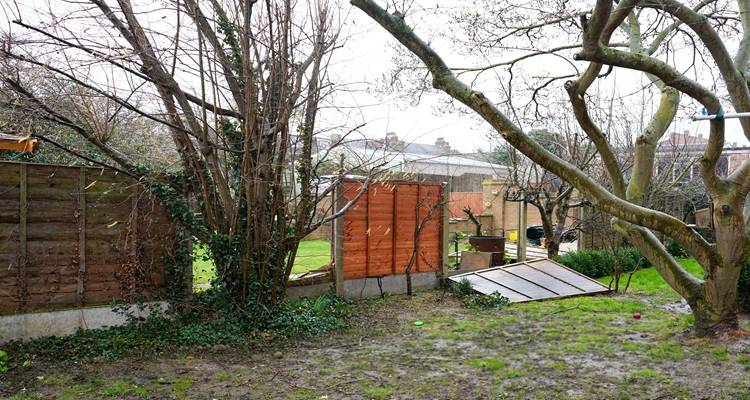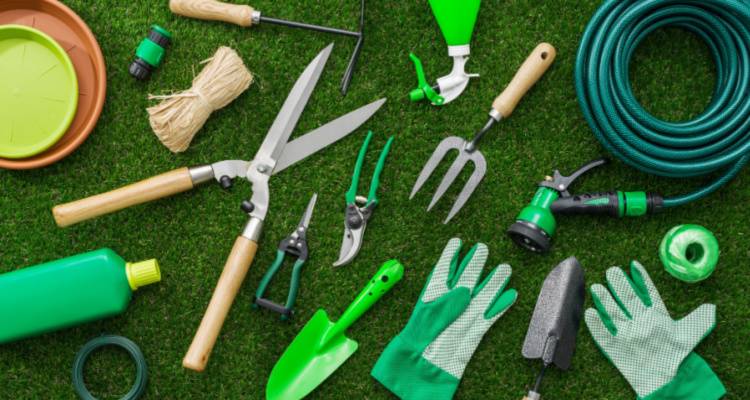Beginner’s Guide to Garden Balconies
Would you like to have a garden balcony added to your property?
In the following article, we'll look at how you can achieve this and what steps you'll need to take. We'll equip you with the knowledge necessary to start your journey in planning the creation of a balcony garden.
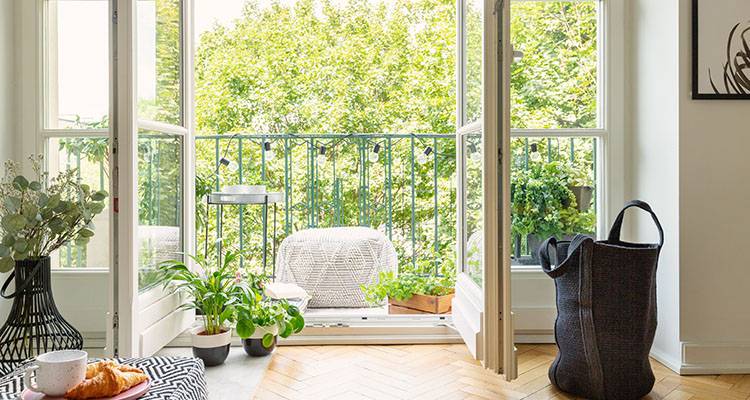
It also covers what a balcony garden is, how to go about choosing the right design, and how to take care of a garden balcony once it's been brought to life.
If you're planning to create one or have a professional put one together for you, the following article will prove very useful!
Contents
- What is a balcony garden?
- Choosing balcony flowers
- Best plants/flowers for south or west-facing balconies
- Best plants/flowers for north or east-facing balconies
- Balcony planters
- Tools for balcony gardening
- Balcony garden design
- Caring for balcony garden plants
- Preventing balcony garden pests
- Conclusion
What Is a Balcony Garden?
First and foremost, let's explore what a garden balcony actually is.
As you may have guessed, this is a sort of balcony that features plant growth and flowers which is where the gardening element comes in. Luscious flowers such as marigolds, potted ivy, decorative hanging plants and even a layer of green lawn turf can appear as standout features of a balcony garden.
What any balcony garden looks like will, of course, vary a lot, and this is where design and plant choices will come into play (which we'll get to in later sections). The great thing is that a garden can be created on any sized balcony.
However, the dimensions of your balcony will influence what's possible, how many plants you'll be able to fit in, and so forth. However, you can definitely turn a balcony into a mini back garden!
You have the widest range of choices available to you if you have a south-facing balcony. A west-facing balcony is the second most preferred option. If you have an east or north-facing balcony, however, there's no need to fret.
While your plant options will be more limited with a north or east-facing balcony, there are many plants which are more suited to shade – and there's also the possibility of artificial plants.
In general, you need somewhere between five and eight hours of access to sunlight for your garden balcony to flourish (although this will obviously depend on what plants appear in your garden balcony).
Choosing Balcony Flowers
Let's now take a look at what flowers are suitable for a balcony.
Choosing the correct flowers and plants for your garden balcony is important since some can wither away fast while others will flourish.
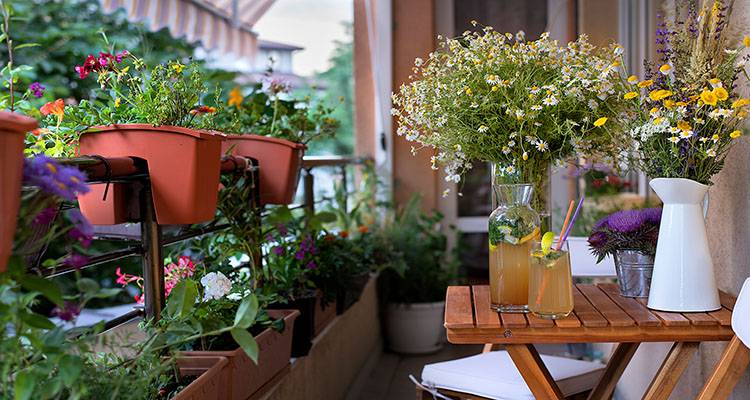
Picking the right options will also depend on your specific balcony, with the likes of geraniums and lobelias being well suited to south or west-facing balconies, while a shaded balcony could feature the likes of floss flower or begonia.
We'll now break down the qualities and requirements of some of the best balcony plants based on the balcony's orientation.
Best Plants for South or West-Facing Balconies
Geranium
This small shrub is a member of the same genus that consists of cranesbills and relative plants.
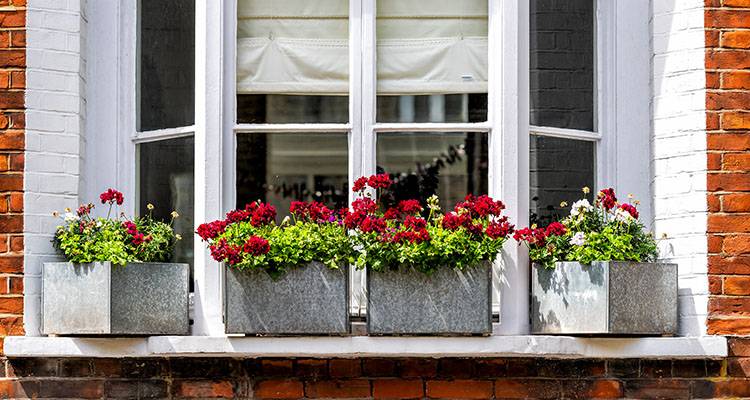
As for their appearance, they have a long, thin fruit which is often described as having the shape of the bill of a crane, hence where the name cranesbill comes from.
| Light requirements | Six hours of direct sunlight each day. |
| Soil requirements | Moist, well-drained soil. |
| Watering frequency | As much as twice per day. |
| Spacing requirements | 30cm apart. |
| Average height | 15-30cm. |
| When does it flower? | Spring. |
Lavender
Another beautiful plant for sun-rich balconies is lavender, and it is arguably one of the best plants for a balcony.
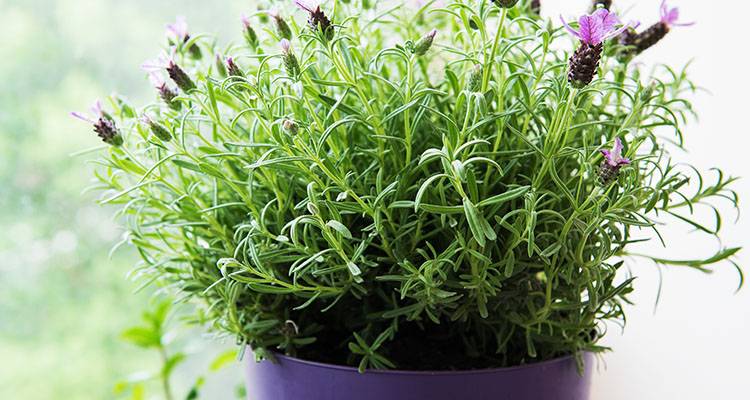
This plant comes in a diverse range of colours which includes white and purple. Lavender is also perfect for establishing informal hedging with its standing flower spikes and close-packed form, which resembles that of a shrub. In addition, this popular Lamiaceae plant sets off an intense aroma which can repel insects.
| Light requirements | 6+ hours of direct and unfiltered sunlight daily. |
| Soil requirements | Moderately alkaline, well-drained soil with a pH level from 6.7 to 7.3. |
| Watering frequency | 1-2 times a week when planted, then every 2-3 weeks prior to the buds forming. After this, go back to watering 1-2 times a week prior to the point of harvest. |
| Spacing requirements | 30-46cm apart. |
| Average height | 40-90cm. |
| When does it flower? | June and July. |
Surfinias
This eye-catching plant is a type of hanging petunia.
Forming wonderfully aesthetic cascades, surfinias display 100s of tiny bell-like flowers and are ideal for covering balconies with a decorative appearance.
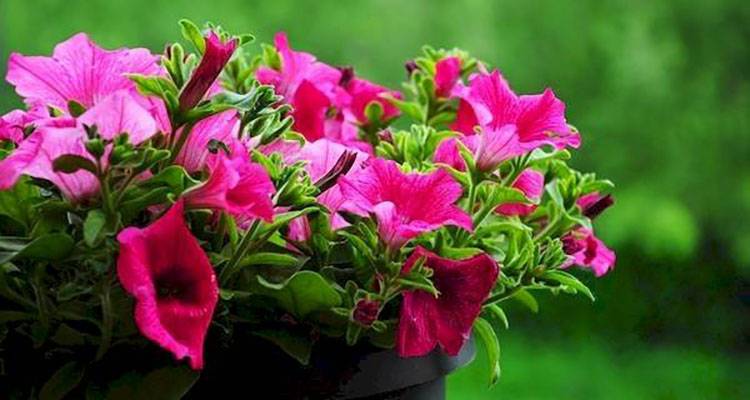
Surfinias come in a range of different colours and will blossom best with full access to sunlight.
| Light requirements | Full sun is most suitable but may blossom in partial shade. |
| Soil requirements | Well-drained mix of perlite/peat with pH levels in the 5.5 to 5.8 range. |
| Watering frequency | Each day in the warmer period of the year, less so at others (note; only water when the topsoil is beginning to dry). |
| Spacing requirements | 20cm apart. |
| Average height | 90cm. |
| When does it flower? | June-October. |
Lobelias
These are an entire genus of flowers, and some types of lobelias grow well in the UK.
Most plant species from this genus grow downwards, which is ideal for cultivating in a hanging planter. Another type of bushy lobelia plant grows straight up. Lobelias tend to feature quintessential violet, blue or white flowers.
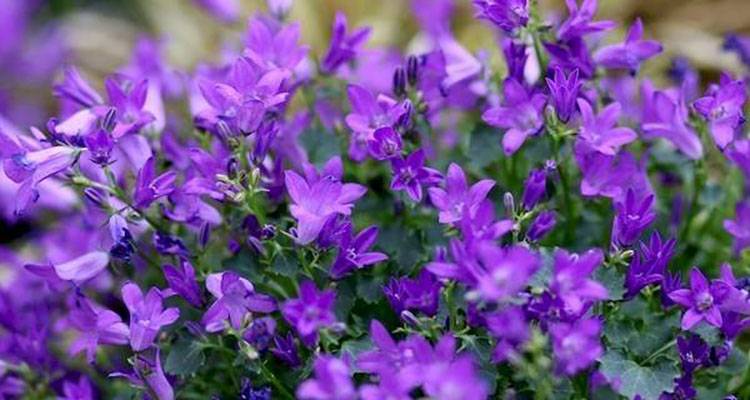
Examples of popular bedding lobelias are Crystal Palace Compact lobelia and Sapphire Compact lobelia, while common perennial lobelias include the various types of lobelia cardinalis and lobelia tupa.
| Light requirements | At least six hours of sunlight per day and should be grown in full sun. Partial shade is acceptable but not ideal. |
| Soil requirements | Rich, fertile soil which can stay moist throughout the summer and won't go dry. |
| Watering frequency | Approximately once a week. You should water at a frequency that ensures the lobelias remain moist but not too wet either. |
| Spacing requirements | 10-15cm apart. |
| Average height | 10-30cm. |
| When does it flower? | Midsummer. |
Best Plants for North or East-Facing Balconies
Begonia
First up on our list of the top plants to grow on a shaded balcony is begonia, which is a popular decorative plant that features beautiful and colourful flowers.
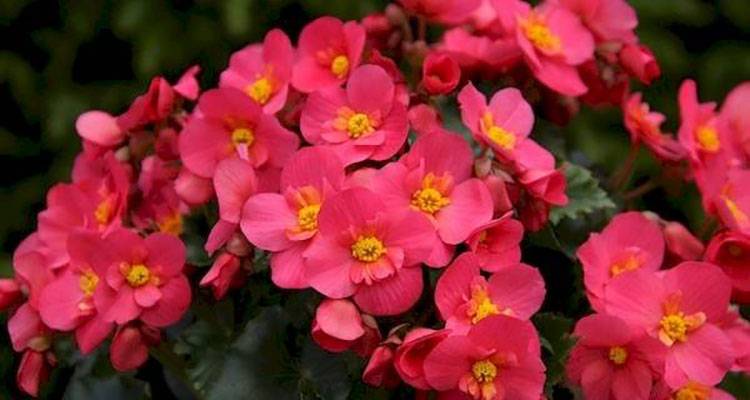
These flowers can come in red, pink or white. Some begonia plants also have decoratively styled foliage. Since these plants can grow and blossom well in shaded areas, they are a perfect option for a north or east-facing balcony!
| Light requirements | Best grown in partial shade with either four to six hours of direct sunlight in the morning or filtered daylight (e.g. trickling through some trees). |
| Soil requirements | Peat-soil or compost-soil formulation. |
| Watering frequency | As soon as the soil goes dry. This is because you want to keep the begonias moist but not too wet. |
| Spacing requirements | 20-30cm apart. |
| Average height | 30-46cm. |
| When does it flower? | From summer until the arrival of frost (usually November or December). |
Fuchsia
These flowering plants tend to comprise small trees or shrubs with flowers being reddish-purple.
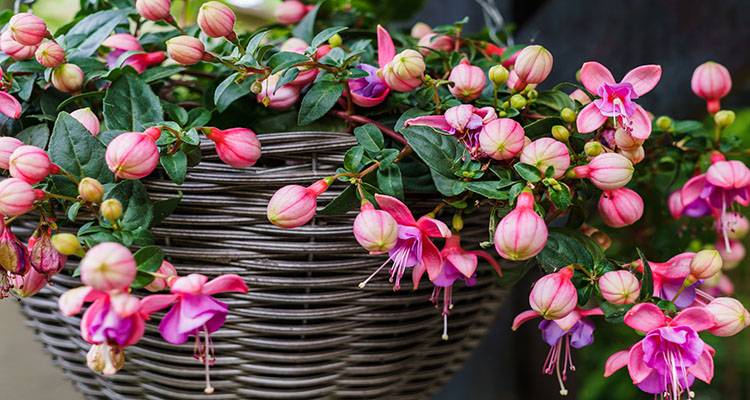
Fuchsias are often allowed to hang downwards, but they can be kept upright with the employment of sticks. Fuchsias can either be vining, trailing or bushy. Despite being an annual plant, you can maintain fuchsias throughout the winter by bringing them indoors before the first frost arrives.
| Light requirements | Grow entirely fine in partial shade. |
| Soil requirements | Well-drained, moist and fertile soil. |
| Watering frequency | For hanging basket fuchsia plants, they should be watered a minimum of once a day during hot weather conditions and either way. You'll want to keep these plants moist so long as they don't become waterlogged. |
| Spacing requirements | 60-90cm apart. |
| Average height | 30-60cm. |
| When does it flower? | April-May (sometimes as early as mid-March). |
Angel's Trumpet
With woody trees or shrubs, these tropical-style plants come with fragrant flowers that hang with a stunning range of yellowish hues. It is most appropriate to grow these plants in a large container.
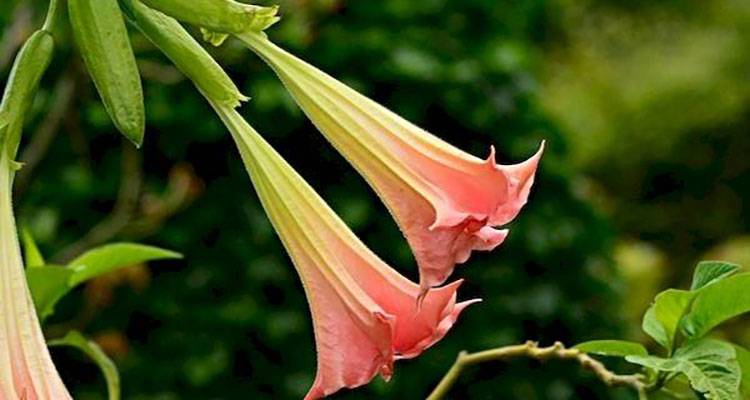
| Light requirements | Fare well in gentle shade or speckled daylight particularly in and around midday. |
| Soil requirements | Acidic soil with a pH level of 5.5 to 7. |
| Watering frequency | Deep watering, but not too often (e.g. once every three days during the summer to a depth of about 7.5cm). |
| Spacing requirements | Follow seed manufacturer's guidelines for spacing requirements. |
| Average height | 180-610cm. |
| When does it flower? | Spring-late autumn (mostly in the autumn months). |
Balcony Planters
In this section, we'll explore the different ways that you can grow balcony plants.
First and foremost, there are balcony flower pots. These containers are placed on the ground or on another surface (e.g. plant pot stand). They are generally the best option for plants that grow upright.
Ceramic pots are one of the two most popular types of plant pots. Since ceramic is porous, your plants are less vulnerable to damage caused by overwatering.
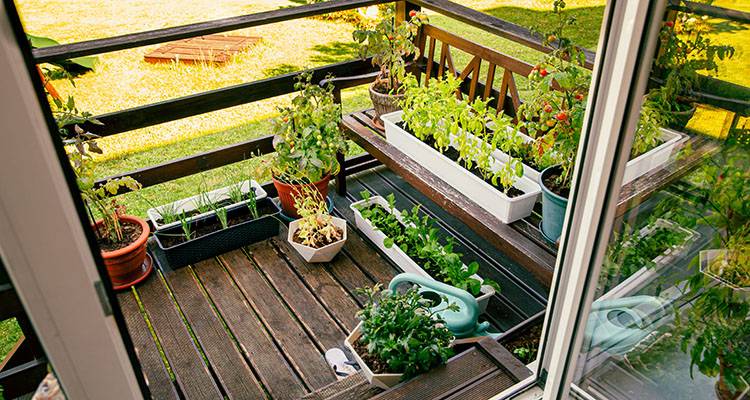
However, plants contained in a ceramic pot will require more frequent watering while plastic pots can be maintained more easily, are lighter and won't break as easily.
Overall, plastic pots are probably the most rational choice for a balcony planter, assuming that it is suitable for the plants you intend to grow.
Alternatively, or in addition, you may wish to use hanging baskets. Certain plants are more suited to this type of balcony planter. Further, hanging baskets can add a decorative element to a balcony and use up less space on the ground. You can use vertical planting containers to create a vertical garden balcony.
You may also choose to hang a variety of pots or other planters vertically. This, as with hanging baskets, can use up space on your balcony more efficiently, thus helping you achieve the desired look for your garden balcony while still hopefully leaving you with enough space to enjoy the area. Another option is that of a balcony garden box.
Tools for Balcony Gardening
So, you've decided what plants you'd like for your garden balcony and you're ready to get started.
At this point, you might be wondering what tools you'll need. Using the right tools for balcony gardening is essential for taking care of your garden space and will, in turn, make it easier to maintain.
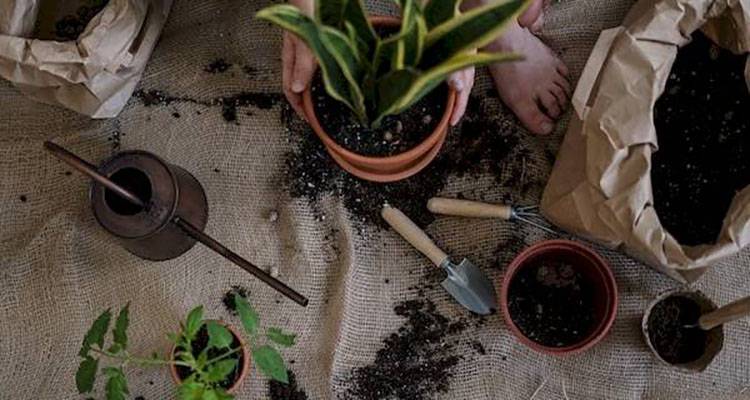
This is because the appropriate tools can keep your plants/flowers healthy, and beautiful, avoid overgrowth and ensure that plants which need it have the necessary support to stay in the correct position. In addition, such tools can prevent or treat diseases or infestations.
Here are the tools that you'll need:
- Protective Gloves – A very important safety tool are gloves that can avoid injuries such as when using sharp tools like pruners. They'll also keep your hands clean and you won't need to worry about touching any critters in your garden.
- Watering Can – This tool/device is an obvious must. You could use a garden hose, but it's more likely to get water everywhere and if you have a wooden balcony, you'd probably want to avoid it getting unnecessarily wet. A watering can is perfect for carefully applying the right amounts of water to your plants and keeping them healthy and hydrated throughout the year.
- Pruner – Pruners could be described as a sort of high-quality gardening scissors. They are designed for pruning plants and removing dead foliage. Pruners are also sharper than scissors and are made to pull off a tidy cut.
- Hand cultivator – You can use this device to rake and till the soil/dirt which is hosting your plants. It contains a handle at one end with 3+ prongs for cultivating on the other.
- Hand trowel – This small gardening tool features a handle and a flattened blade. You can use a trowel to pull up dirt and loosen the soil/dirt that your plant is growing in.
- Pesticides – These chemical products are used to deter or kill unwanted pests. It's important that you purchase a plant-safe option, and ideally it should also be organic. Use appropriately by following the manufacturer's guidelines. If you're worried about a negative impact on biodiversity and the environment, alternatives include polyculture, natural barriers and biocontrol.
- Fertilisers – These products are basically food for plants. They are available in the form of pellets or liquid and can be used to support the healthy growth of the plants/flowers on your garden balcony.
- Soil scoop – If you intend to shovel fertiliser, soil, compost or anything else from a bag to a plant container, then a soil scoop is a perfect choice. With a handle and a ‘walled' scooper, a soil scoop will allow you to move matter from one location to another with ease.
Balcony Garden Design
So how about the layout and appearance of your balcony garden?
You'll want to plan it out such that it is convenient, aesthetically pleasing, easy to maintain, sustainable, and that it meets any other needs and preferences you may have (e.g. preparing it for winter).
Choosing the correct plants is essential. For one, you'll need to consider whether you have a balcony that has plenty of access to direct sunlight or if it is more of a shaded balcony.
As we discussed earlier in the ‘choosing balcony flowers' section, certain plants are more appropriate for a north or east-facing balcony while others are better suited to a south or west-oriented balcony.
Not only that, but you should choose plants which match your skill level. Plants come with varying levels of difficulty in terms of how easy or challenging they are to grow and maintain.
So unless you have lots of previous experience, you should aim to start with beginner plants, whether for your balcony and/or indoors.
Also, of course, you'll also want to choose flowers that not only suit your aesthetic preferences but which will look good together (i.e. flowers with colours that complement one another).

Once you've chosen your plants, you should find out what planters are most fitting to them. After that, you should learn what dirt/soil can be used for each given plant.
You may also wish to winter-proof your garden balcony. In this scenario, you'll need plants that can survive the winter and containers which can protect against frost. Of course, you may also choose to bring some of your plants inside during the winter.
In terms of safety, make sure that you have figured out a way to tie any hanging objects in place correctly. It's also very important to ensure that your balcony can withstand the weight of potted plants and other garden elements.
While it is rare, there is a risk that your balcony could endure damage or even collapse if you have too much on it. Checking with a professional is the best way to ensure that your garden balcony is perfectly safe, which can leave you peace of mind.
After you've ticked all of the essential boxes and you know how to grow a balcony garden, you can think more about its design and appearance.
Would you like it to be a more vertical garden space? Would you prefer to keep it simple? Do you want to include artificial turf? How about adding some suitable seating, such as brown rattan garden benches? Keep in mind all of the key considerations mentioned previously while drawing up your plans.
This can be done yourself, but you may also wish to hire a professional gardener to help out with the design and creation of your garden balcony.
Caring for Balcony Garden Plants
Once you've brought your garden balcony to life, it's important that you take care of your plants/flowers correctly. This is critical to ensure a long-lasting and thriving garden space.
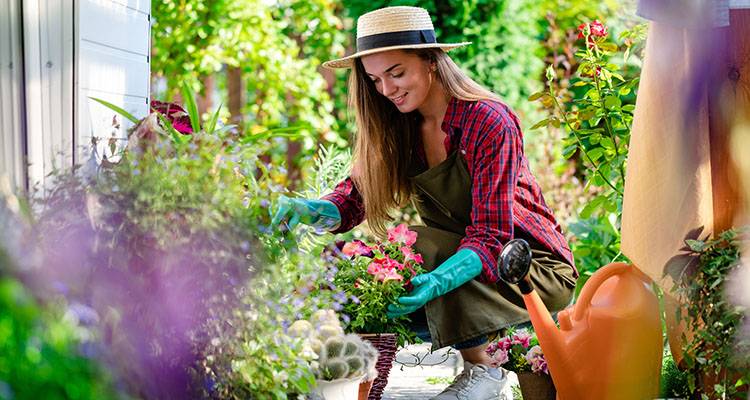
Failure to properly maintain your balcony garden could lead to plants that are overgrowing or not growing enough, plants suffering from disease and a whole host of other gardening problems.
These are types of care you'll need to undertake:
- Watering – Giving your plants the right amounts of water is essential for maintaining healthy growth. The plant's species and weather conditions are both heavily influential in determining how much water you'll need to administer in each case. On average, plants will need watering about once or twice a week, but it really depends on the aforementioned factors. So be sure to research the watering requirements of the plants you intend to grow on your balcony. You might spend between 5 and 10 minutes watering your plants.
- Fertilise – Be sure to fertilise plants with the right product(s). In most cases, you'll need to fertilise your plants every 2-3 weeks (but once more it will depend on what plants you have). Fertilising all of the plants on your garden balcony should only take a couple of minutes.
- Prune plants – You should prune your plants once a year, shortly after they've stopped flowering (usually in late winter or at the beginning of spring). It will likely take you under half an hour to prune the plants on your balcony and it'll probably become a faster and easier process for you with some practice.
- Treat plants – There are plant problems that can arise with plants over time from root rot to yellowing leaves to stunted growth. Many different causes can lead to issues with plants – whether it be pests, disease or poor plant management (e.g. under or overwatering). It's important that you identify any problems as soon as possible and find the right products or/and methods to treat them. If these issues are left unchecked, they will likely only worsen with time. Different plants are more prone to certain issues, so once again researching the plants that you plan to grow is a good way to be prepared for issues ahead of time. Treating plants could be a simple five-minute solution or take weeks or months of dedication to fix. It'll really depend on the nature of the problem.
- Clean up – It's a good idea to perform a general clean of your garden balcony either on a regular basis as short jobs or as a big clean up in the autumn. This may take a few minutes if done frequently or perhaps around an hour or so if undertaken annually.
Preventing Balcony Garden Pests
As with disease, garden pests are a common threat to balcony plants. Some pests to watch out for are whiteflies, aphids, thrips and spider mites. Let's take a look at how to prevent or/and get rid of these insects in more detail.
Common balcony garden pests:
- Aphids – These small pear-like insects feature slim, long mouths and are a threat to a wide variety of plants. They tend to leave behind a honeydew substance which can result in dark and sooty mould. Other symptoms of aphid damage are falling leaves and warped foliage. You should either use an insecticidal soap or a diluted washing up liquid spray. This should comprise of a few drops mixed with about 1000ml of water. To deter them in the first place, try horticultural oils or neem oils.
- Spider mites – These miniature spiders are barely visible with the naked eye, but they can become a pertinent barrier to healthy plant growth. Signs of spider mite damage include small brown or yellow spots on leaves, entirely yellow leaves which are failing to grow and even spider webbing. Ways to prevent spider mites include bug blockers, predator sachets and sterilisation. To treat an infestation, you can use botanical insecticides or insecticidal soap.
- Whiteflies – Next we have these deceptively named insects that are in fact not flies but are a relative of aphids. The presence of honeydew, black and sooty mould or plant fronds which are growing out of honeydew all point to the presence of whiteflies. Once more, insecticidal soap is the best solution to treat a whitefly infestation.
- Thrips – These small and numerous insect species can sometimes be beneficial for plants, but in many cases they can cause issues. Evidence of a thrip infestation includes small dark green dots that are present on leaves. Such spots can become silver or white if left untreated. In the worst-case scenario, leaf tissues will fall off the plant. In order of effectiveness, you could start by pruning infested plants on a regular basis, trying a mild insecticide and if all else fails, neem oil or once more, an insecticidal soap could be used.
These are just some of the most prevalent plant pests in the UK. There are many more to be wary of. All in all, it's important that you pay attention to your plants so that you can spot any unexpected or unusual changes in their appearance or growth behaviour and in turn detect infestations right away!
Conclusion
We hope you enjoyed our beginner guide on balcony planting and gardening and that you found it both resourceful and helpful. We've looked at what a garden balcony is, how you can design one, what tools and safety steps you'll need and what flowers you may wish to include.
This article has also explored the various types of balcony planters, how a garden balcony can be maintained and how to prevent or remove common plant pests.
There are, of course, many possibilities when it comes to a garden balcony with options for a small balcony garden or a medium or large-sized balcony. So take your time, do some research and check out the various balcony garden ideas showcased on the web.
For instance, try Googling ‘garden balcony ideas' and ‘garden balcony design ideas', and you'll discover hundreds of layouts and thoughts for creating the ideal apartment garden.
Many people who live in a flat may be left disappointed that they don't have a natural back garden to relax in on a warm summer's day, but with a garden balcony, it's now possible to emulate that to a large extent. So put your thinking cap on, be inspired, and you can bring your very own garden balcony to life!
Sources
https://learn.eartheasy.com/articles/how-to-create-a-balcony-garden/
https://www.beechcroft.co.uk/blog/balcony-gardening
https://www.bhg.com/gardening/vegetable/vegetables/planning-your-first-vegetable-garden/
https://homeguides.sfgate.com/much-sunlight-geranium-plant-need-70043.html
https://www.gardeningknowhow.com/ornamental/flowers/geranium/geranium-care.htm
https://www.geraniumrozanne.com/how-far-apart-should-i-plant-my-geraniums/
https://www.bhg.com/gardening/plant-dictionary/annual/geranium/
https://www.gardenguides.com/many-hours-sun-lavender-plant-need-5970.html
https://www.almanac.com/plant/lavender
https://www.greenhousegrower.com/crops/surfinia-petunias-production-secrets/
https://www.gardenbargains.com/item-p-400078/surfinia-trailing-petunia-collection
https://www.gardeningknowhow.com/ornamental/flowers/lobelia/lobelia.htm
https://www.gardeningknowhow.com/ornamental/flowers/lobelia/lobelia.htm
https://www.lovethegarden.com/uk-en/article/lobelia-cardinal-flower-lobelia
https://www.rhs.org.uk/advice/profile?pid=815
https://pss.uvm.edu/ppp/articles/begoniain.html
http://www.balconycontainergardening.com/gardening/225-must-have-garden-tools
https://www.chatelaine.com/home-decor/top-10-balcony-gardening-tips/
https://blog.gardeningknowhow.com/top-of-the-crop/top-5-pests-attack-garden-plants/
Last updated by MyJobQuote on 8th February 2023.
